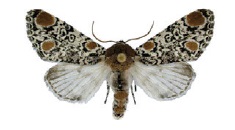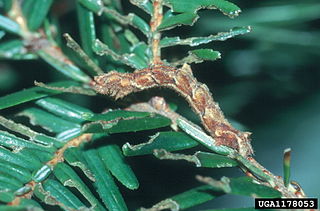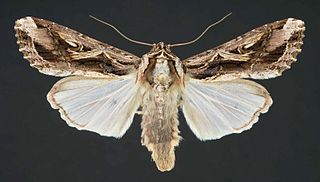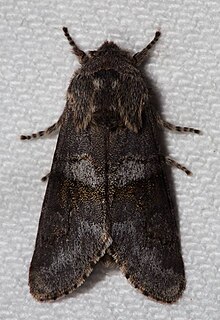
Yucca is a genus of perennial shrubs and trees in the family Asparagaceae, subfamily Agavoideae. Its 40–50 species are notable for their rosettes of evergreen, tough, sword-shaped leaves and large terminal panicles of white or whitish flowers. They are native to the hot and dry (arid) parts of the Americas and the Caribbean.

The Arctiinae are a large and diverse subfamily of moths, with around 11,000 species found all over the world, including 6,000 neotropical species. This group includes the groups commonly known as tiger moths, which usually have bright colours, footmen, which are usually much drabber, lichen moths, and wasp moths. Many species have "hairy" caterpillars that are popularly known as woolly bears or woolly worms. The scientific name of this subfamily refers to this hairiness. Some species within the Arctiinae have the word tussock in their common name due to people misidentifying them as members of the Lymantriinae based on the characteristics of the larvae.

Schinia, commonly called flower moths, is a large genus of moths belonging to the family Noctuidae. The genus has a Holarctic distribution with the vast majority of species being found in North America, many with a very restricted range and larval food plant.

Agnorisma bollii is a moth of the family Noctuidae. This species of moth is "apparently rare" in its range with occurrences in a limited number of states west of the Appalachians, and the Chesapeake Bay region of Maryland. The range of this species appears to be in the states of Maryland, Ohio, Kentucky, Arkansas and Kansas. There were specimens discovered in South Carolina, but is too soon to tell if the species is newly introduced or a remnant population.

Anomis erosa, the yellow scallop moth or abutilon moth, is a moth of the family Erebidae. The species was first described by Jacob Hübner in 1821. It is found in south-eastern North America. It is mostly a southern species, but migrants reach Manitoba, Quebec and Maine.

Schinia nundina, the goldenrod flower moth, is a moth of the family Noctuidae. The species was first described by Dru Drury in 1773. It is found in North America from Minnesota to southern Ontario and Nova Scotia, south to central Florida and southern Texas. Records include Arizona, Kansas, Nebraska, New York, Maryland, Oklahoma and South Carolina.
Hypocoena inquinata, the sordid wainscot or tufted sedge moth, is a moth of the family Noctuidae. The species was first described by Achille Guenée in 1852. It is found across Canada from Newfoundland to British Columbia, south in the east to Connecticut and Ohio and in the west to Colorado.

Acronicta modica, the medium dagger moth, is a moth of the family Noctuidae. It is found from Ontario and Quebec south to Arizona and Texas. It has also been recorded from Pennsylvania, Maryland, Iowa and Wisconsin.
Acronicta tristis is a moth of the family Noctuidae. It is found from Ontario, Quebec and New Brunswick, south to Maryland, Pennsylvania and Ohio.

Acronicta fallax, the green marvel, is a moth of the family Noctuidae. The species was first described by Gottlieb August Wilhelm Herrich-Schäffer in 1854. It is found in most of North America, from Ontario, Quebec, New Brunswick, Nova Scotia, Newfoundland and Labrador and Manitoba south to Arizona and Florida.

Harrisimemna trisignata, or Harris's three spot, is a moth of the family Noctuidae. The species was first described by Francis Walker in 1856. It is found in North America from Ontario, Quebec, New Brunswick, Nova Scotia, Newfoundland and Labrador, Alberta and Saskatchewan, south to Arizona. In the United States it has been recorded in Maryland, Pennsylvania, Wisconsin, Georgia, Illinois, Indiana, Iowa, New York, Ohio, Oklahoma, Tennessee, Texas and Virginia.

Raphia frater, the Brother Moth, is a moth of the family Noctuidae. It is found from Nova Scotia west, across the forested regions of Canada to British Columbia, south to Mississippi in the east. The southern limits in the west are uncertain due to confusion with several closely related species or forms.
Gabara subnivosella, the wet sand savannah moth, is a moth in the family Erebidae. The species was first described by Francis Walker in 1866. It is found in North America from Manitoba south to Maryland, Massachusetts and New York.

Schinia nubila, the camphorweed flower moth or brown flower moth, is a moth of the family Noctuidae. The species was first described by Herman Strecker in 1876. It is found from the US states of Oklahoma to New Jersey, south to Florida and Texas. Its range is expanding in the northeast. Furthermore, recorded from Colorado, Kansas, Oklahoma, Arkansas, North Carolina, South Carolina and Maryland.

Achatia distincta, the distinct quaker, is a moth of the family Noctuidae. The species was first described by Jacob Hübner in 1813. It is found from coast to coast in most of United States and south-eastern Canada.

Scopula junctaria, the simple wave, is a moth of the family Geometridae. The species was first described by Francis Walker in 1861. It is found in the whole of Canada and the northern United States, south to Maryland, Arizona, and California.

Nemoria mimosaria, the white-fringed emerald or flanged looper, is a moth of the family Geometridae. The species was first described by Achille Guenée in 1858. It is found from Nova Scotia to south-eastern Alberta, south to Virginia, Illinois, and Texas.

Spodoptera dolichos, the dolichos armyworm moth or sweetpotato armyworm moth, is a moth of the family Noctuidae. The species was first described by Johan Christian Fabricius in 1794. It is found from the southern United States, south through Costa Rica to South America, as far south as Argentina. In the United States, it may occur as far north as Kentucky and Maryland.

Synchlora aerata, the wavy-lined emerald moth or camouflaged looper, is a species of moth of the family Geometridae. The species was described by Johan Christian Fabricius in 1798. It is found in most of North America.

Ptichodis herbarum, the common ptichodis moth, is a moth in the family Erebidae. It is found in the United States. It has also been recorded from Jamaica.

















